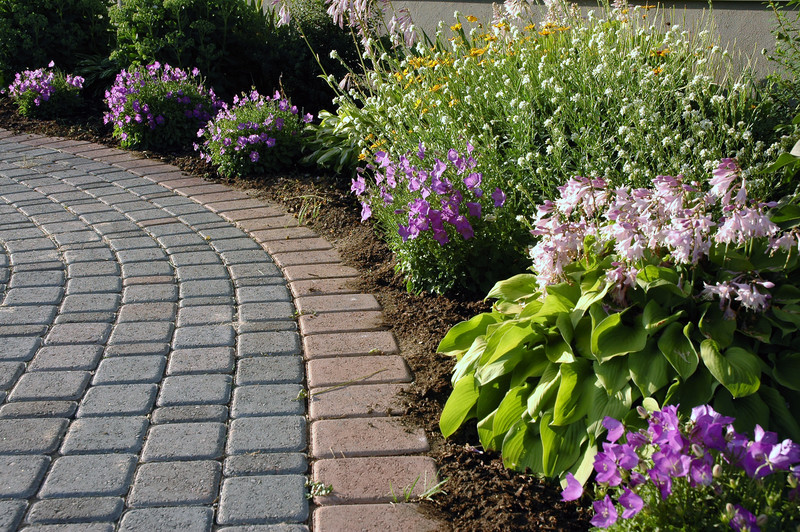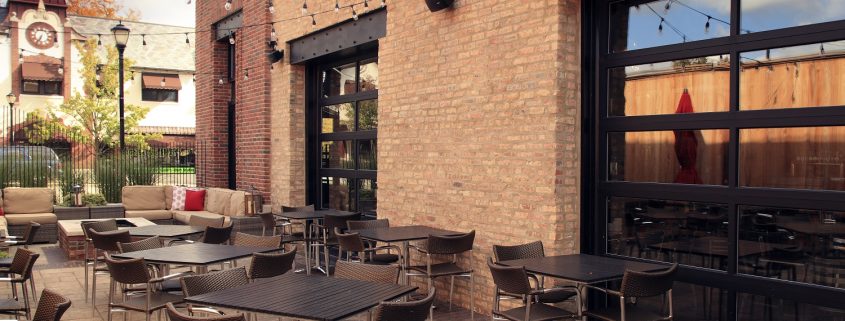Permeable Paving

Permeable paving at Mickey Finn’s Brewery in Libertyville, IL
Permeable paving benefits communities by reducing the amount of impervious surface and runoff. Interlocking concrete pavers make up an attractive, durable, and low-maintenance permeable paving surface. Consider using permeable pavement for your next driveway, patio, or walkway project.
What is it?
Permeable: having pores or openings that permit liquids or gases to pass through.
Permeable paving products were developed as a result of concerns about surface runoff. Rainwater runoff from traditional monolithic concrete and asphalt paving can lead to erosion, flooding, and pollution. Municipalities responded to these concerns by limiting the extent of impermeable paving.
Building and property owners have embraced permeable paving as a way to include additional paved surfaces, beyond that which is allowed by code. Permeable paving allows owners to include additional walks, parking lots, patios, and other paved surfaces, without adding to the runoff problem.
Here’s how it works! The product surface is a series of permeable concrete pavers. The joints between the pavers are filled with small stones. These stone-filled joints and the pavers themselves allow water to flow into a base of aggregate. The spaces between the aggregate can take on water. The water makes its way into the soil below, reducing surface runoff.
What are the benefits?
The main benefits of permeable paving are in the areas of stormwater management and aesthetics.
- Stormwater Management
Permeable paving allows rainwater to permeate the units themselves, as well as the joints between the units. The rainwater enters the crushed stone base that supports the system of pavers. Finally, it enters the soil. This system dramatically reduces runoff. In addition, pollutants are filtered prior to entering local natural waterways.
Permeable paving can even be used over impervious soils. In this case, a system of drain piping is installed below the paving to direct excess rainwater away.
Pro Tips! To gain the most benefit from permeable paving, it is recommended that the surface be cleaned at least once a year to remove clogged pavement openings. In areas where freezing is encountered, deicing salts should be applied to melt ice and reduce slipping hazards. Sand should not be used.
- Aesthetics
Units which make up permeable paving are very attractive. When assembled as interlocking units, they look much like brick paving. Most people don’t realize they are made of concrete materials.
Permeable paving has been embraced by luxury homeowners, restaurants, and retail outlets for its aesthetic appeal. Patios, driveways, walkways, and pool decks are popular applications for permeable paving.
Many attractive unit options are available in a variety of colors and shapes. These can be mixed to coordinate with surrounding paving materials. Landscape companies and home center stores are the primary source of materials.
- Handicapped Accessibility
Permeable paving is firm, stable, and slip resistant. As such, it is in keeping with ADA design guidelines. Although it is made up of many small units, the system is stable and can be used to provide handicapped accessibility. Visually impaired people and those who use mobility devices, such as wheelchairs and walkers, can navigate the permeable surface.
 Where can I find it?
Where can I find it?
Permeable paving is a popular, cost-effective product found at home center stores and through paving contractors and landscape companies. Popular product manufacturers include Belgard, Unilock, and EP Henry.
Consider using permeable pavement for your next outdoor project. It is an attractive, durable, and low-maintenance permeable surface. You can learn more about the product and its benefits from ICPI, the Interlocking Concrete Pavement Institute.



